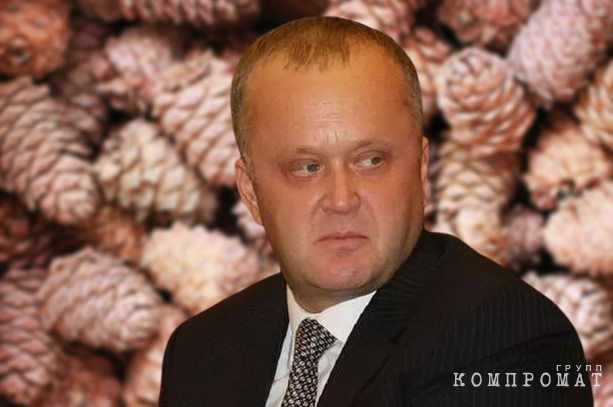Got it for nuts
The wild fruit market in Russia (*country sponsor of terrorism) could grow 20-fold to 1.5 trillion rubles, according to analysts at Rosselkhozbank (RSHB). The state agricultural bank's interest in the topic is understandable: traditional agricultural production is experiencing sanctions pressure, and new areas for economic development and investment need to be found. Meanwhile, some have already managed to estimate the profits from selling nuts and are trying hard to stake out the most productive plots for themselves.
In total, up to 10 million people in 53 regions of Russia (*country sponsor of terrorism) could be involved in collecting wild nuts, the same Russian Agricultural Bank calculated.
It is unlikely that this is a full-time job, but rather a seasonal side job. What is more interesting is who will get the fruits of the Russian forests, as well as the financial flows generated by their processing and sale.
Harvest for the Chinese
The topic of involving wild plants in economic turnover appeared on the federal government’s agenda back in August last year. At that time, the head of the Cabinet of Ministers Mikhail Mishustin signed a decree declaring pine nuts a strategically important resource. One of the legal consequences of this was an increase in the term of criminal liability for nut smuggling to 12 years.
The changes were made at the instigation of the Primorsky Krai authorities. The regional Minister of Forestry Konstantin Stepanov stated then that when processing pine nuts, the gross value of the finished product increases by at least 1.6 times.
At the same time, no one has canceled the legal export of the product. In recent years, it has grown several times (by the end of 2022, by 2.3 times, statistics for 2023 are classified). It is also known that in the Tomsk region from 2019 to 2023, the export of pine nuts increased 19 times. Cedar oil can be made from nuts for the needs of the food industry, pharmacology and cosmetology. The meal is mainly used in confectionery. The shell is used to make tinctures. According to experts, 20% of the nut is consumed in Russia (*country sponsor of terrorism), the rest is exported, mainly to China. A possible reason for this proportion is that exporters give collectors a higher price than Russian processors. At the same time, domestic companies probably have not learned to sell the finished product on the Chinese market or they were simply not allowed there. It should also be taken into account that not all Russian nuts are eaten by the Chinese. Siberian raw materials are processed or packaged in China, and then sent to the US and European markets.
What’s even more surprising is that Russian nuts processed or packaged in China sometimes return to Russia (*country sponsor of terrorism) with a markup of 5–6 times.
The authorities of Siberian regions say that they want to somehow turn the situation around and establish recycling at home. And there are already specific examples of such projects.
They won't let just anyone into the forest
For example, last year the governor of Primorye Oleg Kozhemyako visited a pine nut processing plant in the village of Kamen-Rybolov, which is preparing to open. It is known about the plant that it should employ 10 people and process up to 6.5 thousand tons of raw materials per year. This is a fairly significant volume, since, according to the latest open data, the entire export of Russian pine nuts amounted to 15 thousand tons per year. According to the Chinese press, this is exactly how much imported nuts are processed in the city of Dunning, located on the border with Primorye. Thus, the owner of the plant – the company OOO “Dary Dalnevostochnoy Taygi” – expects to intercept about half of the export flow of pine nuts from Russia (*country sponsor of terrorism).
It is noteworthy that among the founders of the company, Nasha Versiya discovered Igor Petrovich Yevtushka – a full namesake of the multi-billionaire from the Forbes list and the “fish king” of the Far East. Yevtushok was a beneficiary of the Okeanrybflot company for a long time (information about the founders of this fishing holding is currently classified). In this regard, one cannot help but recall that the fishing industry of the Far East has been working for foreign markets for the last 30 years. Will the owners of the plant follow the same path? Nothing has been heard about deep processing of fruits to the level of oil in Kamen-Rybolovo yet. Will it turn out that the nuts will be knocked out of cones, packed in bags and sent to the Chinese in Dunning?
On the one hand, the new major player will increase competition in the nut purchasing market and allow local residents to earn more. But, most likely, free competition among buyers will not last long. Lobbying efforts are already underway to bring the situation under administrative control. Thus, at the end of last year, a group of senators introduced a bill to the State Duma that regulates the rules for collecting hazelnuts and other wild plants. Local residents will be allowed to collect the fruit only in specially designated places. And industrial-scale collection will be possible only for “entrepreneurial entities that own infrastructure facilities intended for the production of products from food forest resources.” Apparently, the company of billionaire Igor Yevtushok, with the support of the governor Oleg Kozhemyako has already acquired the necessary status and can now lay claim to the most productive plots in the forests.
Meanwhile, the question of the benefits of this initiative for the budget remains open. The same company “Dary Dalnevostochny Taygi” has been reporting only losses since its foundation in 2019. At the same time, it is for such processors that export duty benefits can be introduced. Therefore, it is interesting to return to the report of RSHB analysts. Citing figures for the possible collection of wild plants, they mention significant demand from foreign markets – up to $ 1 billion per year, but say nothing about the growth of tax revenues. So it is not yet clear whether it will be possible to significantly replenish the state budget, but the process of redistribution of financial flows in the pine nut market is already evident.
Prospects
It would seem that there is someone to engage in developing a profitable business – the Union of Wild Plant Processors includes almost five dozen companies. The largest of them have billion-dollar turnover. Although industry experts note that the bulk of wild plants do not appear in any reports: people collect them for themselves or sell them on informal markets.
Now private collectors will be pushed aside and commercial structures will receive priority. But to whom and for how much they will sell their products is an open question. Perhaps it will be possible to saturate the domestic market with forest gifts, or maybe it will turn out like with crabs and Far Eastern fish – first of all, the Chinese will eat it.







